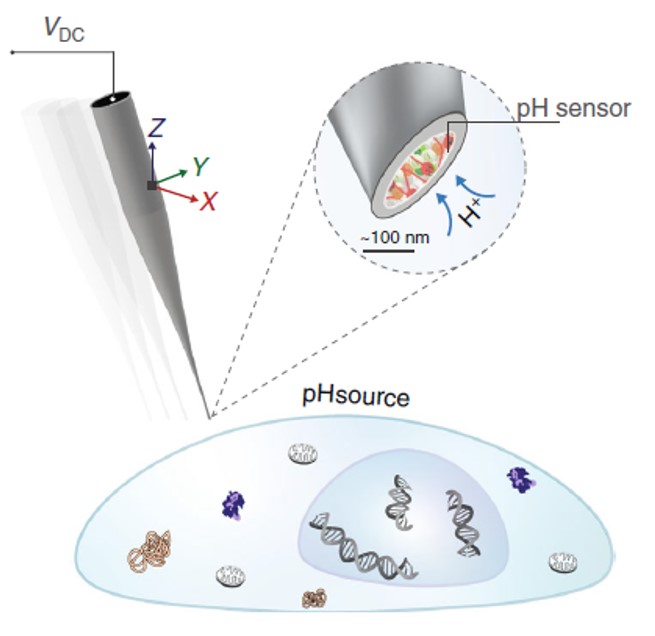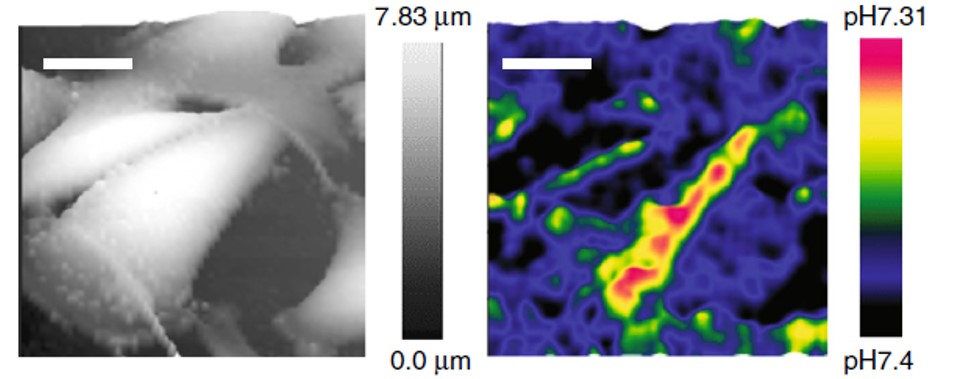Abstract:
Nanopipettes with zwitterionic membranes may offer improved monitoring of changes in pH surrounding living cells, which can indicate traits of invasive cancer cells and their response to treatment, report researchers at Kanazawa University in Nature Communications.
”It is becoming clear that an acid extracellular pH plays an essential role in cancer cell progression, invasiveness and resistance to therapy,” explain Yuri Korchev and Yasufumi Takahashi at Nano Life Science Institute of Kanazawa University and Yanjun Zhang at Imperial College London and colleagues at collaborating institutions in the UK, China, Japan and Russia in a recent paper. Despite the growing recognition of the importance of the pH directly surrounding a cell as an indicator of cell health, techniques to measure it so far remain limited in terms of their sensitivity, the spatial resolution they can offer and the speed of response to pH changes. Reporting in Nature Communications, Zhang, Takahashi and Korchev and colleagues describe a nanopipette pH biosensor that is sensitive to changes in pH of less than 0.01 units with a response time of 2 ms and 50 nm spatial resolution.
The researchers originally designed the sensor as a nanopipette ionic field effect transistor – where gates control the flow of ions in the nanopipette instead of electrons. However, while this tackled issues around pH sensitivity and spatial resolution, the device readings still took a few seconds to respond to pH changes due to ionic Coulomb blockade effects hampering the diffusion rate of ions.
The solution Zhang, Takahashi and Korchev and colleagues now propose is to incorporate a zwitterionic membrane to enable faster responses. By using a twin barrel nanopipette with the membrane in just one of the barrels the researchers were able to use the other barrel as a scanning ionic conductance microscope (SICM) for simultaneous topological measurements.
The team tested the device on live cancer cells and showed how the device could pick up on increases in extracellular pH from invasive phenotypes of breast cancer cells that had been deprived of estrogen. They could also detect pH changes from algae exposed to sunlight, caused by the uptake of inorganic carbon in photosynthesis, as well as identifying heterogeneities in aggressive melanoma cells from high-resolution pH maps.
Highlighting the real-time feedback-controlled dynamic 3D mapping of extracellular pH that their tool allows, and the heterogeneities of cancer cells that it can detect “label-free and at subcellular resolution” they conclude, ”This method could help with cancer diagnosis, prognosis, and in evaluating acidic pHe [extracellular pH] targeted therapies.”

Figure 1.
The operation of the double-barrel nanoprobe for simultaneous SICM imaging and pH measurement. Courtesy of Nature Communications

Figure 2.
High-resolution 3D pHe mapping of living melanoma cells with feedback-controlled double-barrel SICM-pH nanoprobe. The 3D SICM topographical images (left column) and 3D pHe distributions (right column) of low-buffered living melanoma A375M obtained simultaneously by a single SICM scanning, which demonstrated a highly variegated distribution pattern of pHe. Scale bars represent 20 μm. Courtesy of Nature Communications
[Background]
Limitations of previous techniques
The most commonly used pH probes at present are based on microelectrodes that are quite large in comparison to the scale of the pH fluctuations of interest in studies of extracellular pH. Alternatives have been based on changes in the fluorescence of molecules, nuclear magnetic resonance imaging and positron emission computed tomography. However, monitoring fluorescence is subject to background noise and photobleaching, and the other techniques have poor spatial resolution and raise difficulties in quantification because they are based on the distribution of probes within tissue.
By using a nanopipette as an ionic field effect transistor, the researchers were able to overcome most of the issues limiting previous techniques. However mutual same charge repulsion leads to the Coulomb blockade effect, which starts to inhibit the diffusion of positively charged protonated water molecules in the nanopipette and this slows down the response time.
Zwitterionic membrane
A zwitterion is an uncharged molecule containing opposingly charged functional groups. For the zwitterionic membrane in the nanopipette the researchers self-assemble a hydrogel from poly-l-lysine (PLL) and glucose oxidase (GOx), which has advantages in terms of cost and stability. The PLL has positively charged quaternary amine groups and the GOx has a negatively charged carboxylic acid residue group. The presence of glutaraldehyde vapour can then crosslink the resulting PLL/GOx hydrogel.
In neutral pH the zwitterionic membrane presents both positively and negatively charged functional groups but in low pH conditions the positive amine groups dominate so that negative anions preferentially diffuse through the membrane avoiding an ionic Coulomb blockade.
Article
High-resolution label-free 3D mapping of extracellular pH of single living cells
Journal: Nature Communications
Authors: Yanjun Zhang, Yasufumi Takahashi, Sung Pil Hong, Fengjie Liu, Joanna Bednarska, Philip S Goff, Pavel Novak, Andrew Shevchuk, Sahana Gopal, Iros Barozzi, Luca Magnani, Hideki Sakai, Yoshimoto Suguru, Takuto Fujii, Alexander Erofeev, Peter Gorelkin, Alexander Majouga, Dominik J Weiss, Christopher Edwards, Aleksandar P. Ivanov, David Klenerman, Elena V. Sviderskaya, Joshua B. Edel, Yuri Korchev
DOI: 10.1038/s41467-019-13535-1
Funder
World Premier International Research Center Initiative (WPI), MEXT, Japan; JST PRESTO (JPMJPR14FA); JSPS KAKENHI (15K15029 and 17K08531) and others



 PAGE TOP
PAGE TOP